- 928
- 575
Movies and Series
Problem with Vertical FOV Usage
The main problem with using a vertical FOV of 70° in distance calculations is that it generates a distorted image in the results, as most movies and series do not use such a wide vertical FOV. Instead, the film and television industry commonly uses a standard horizontal FOV of 70° or close to this value.

The use of a vertical FOV creates inconsistencies because a vertical FOV of 70° implies a horizontal FOV of over 100° in a 16:9 aspect ratio, which would lead to visible distortions in the image, but this does not occur in film productions. Therefore, using the vertical FOV does not accurately reflect what we see on screen.
Cameras in movies typically use horizontal FOV values ranging from 60° to 75°, which provides a more realistic representation of the scene. By assuming a vertical FOV of 70°, the viewing angle is exaggerated, and therefore the measured distances are less than the actual ones, which affects the accuracy of distance calculations in action scenes.
For example, in the film industry, it is common to use 35 mm and 28 mm lenses, which offer a diagonal field of view of 63° and 75°, respectively.


Examples of Incorrect Calculations
Case N°1
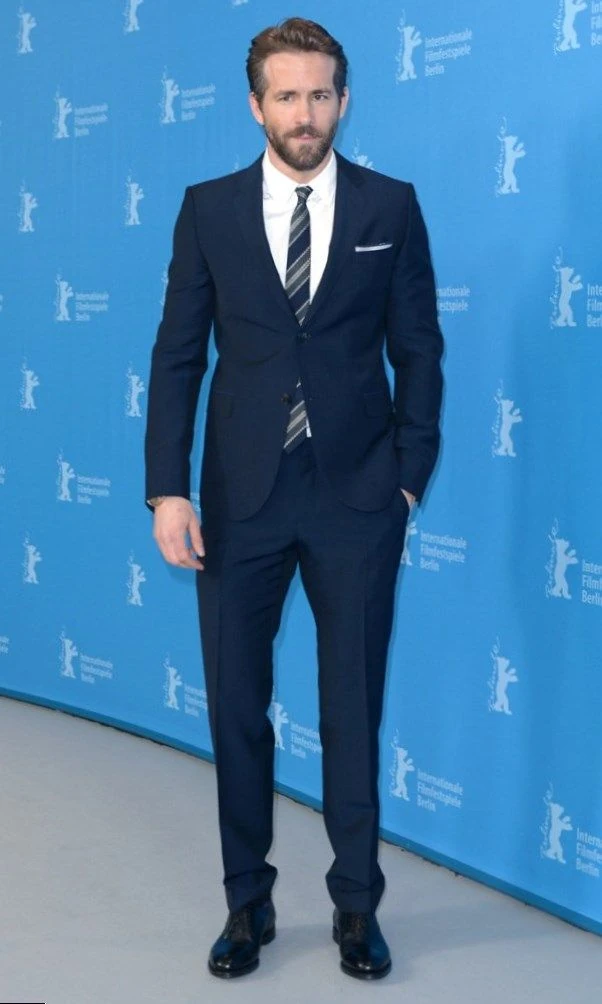
X-Men Franchise: Wade Wilson Slices Bullets
Ryan Reynolds head distance calculation: 0.2966222 * 818 / [200 * 2 * tan(70deg/2)] = 0.86m | 86cm
Subsequently, the camera zooms in, suggesting that the actual distance decreases. However, we observe Ryan wielding his arm with a katana right in front of the camera. The approximate length of Ryan's arm is 82 cm, while a katana measures between 60 and 75 cm, giving us a total length of approximately 142 cm. This discrepancy from the calculated distance of 86 cm indicates that the use of a 70° vertical FOV may not be the most appropriate for this analysis.
Case N°2
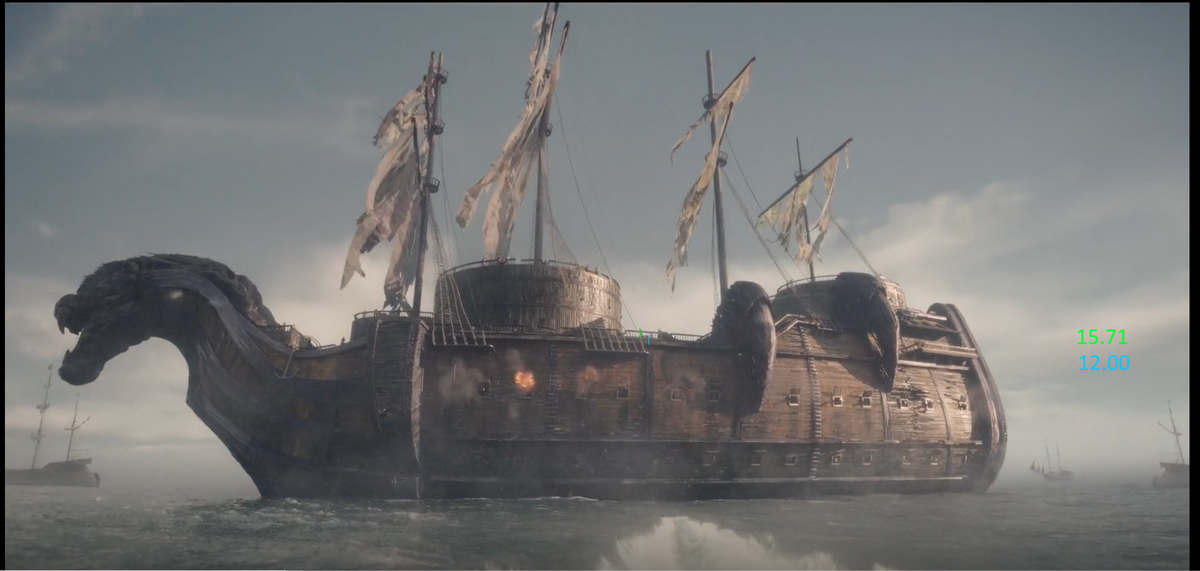
One Piece Netflix feat compilation 2
Calculation of distance to Arlong's head: 0.309033333m * 617/[126.78*2tan(70deg/2)] = 1.07m
In the panel, we can notice that between the camera and Arlong is Luffy, who has his arms outstretched, which should measure more than a meter. Arlong, also with his arms outstretched, is approximately 80 cm long. Despite this, he is still a considerable distance from the camera, which is supposed to be only 1 meter away. This discrepancy is hard to believe given the visual context, suggesting that the actual distance between Arlong and the camera is considerably greater.
Case N°3
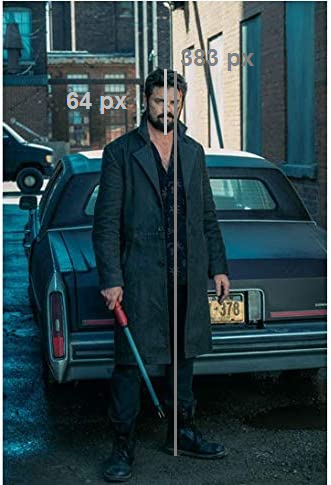
Homelander outspeeds an explosion
0.22118644068 * 545/[197 * 2 * tan(70deg/2)] = 0.43m | 43cm
The calculated distance is highly questionable. Anyone observing the scene can conclude that Homelander is not only 43 cm (less than two feet) from the camera. This remarkable discrepancy suggests that the use of a 70° vertical FOV is inappropriate for this analysis, indicating that the actual distance between him and the camera is considerably greater.
Also, let's look at this scene where Homelander's head is shown in a much larger proportion on screen, implying a smaller distance, and yet looking at the behind-the-scenes, it is apparent that the camera is at least a meter away from him.

Case N°4
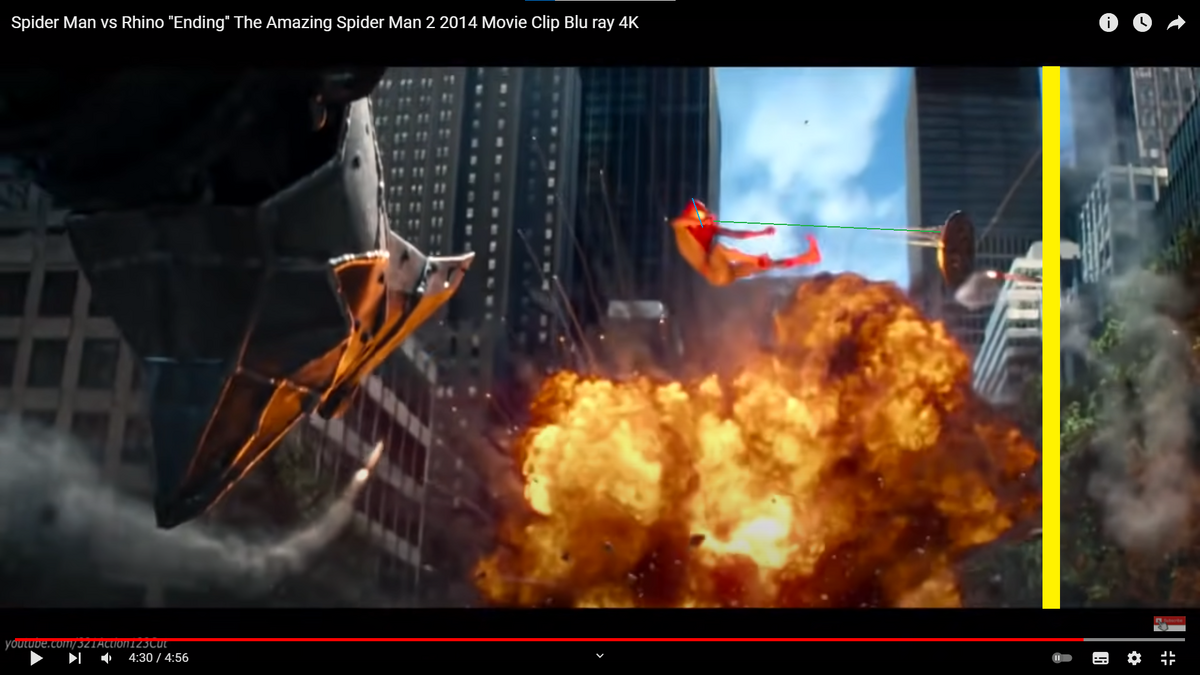
Amazing Spider-Man: Spider-Man swings a manhole very fast
0.2482 * 868 /[47 * 2 * tan(70deg/2)] = 3.27m
In this scene, we observe Spider-Man extending his arm with a webbing hooked to a manhole cover, which is positioned right in front of the camera. The length of the arm, combined with the webbing, exceeds 2 meters. However, despite this measurement, it appears that Spider-Man is a considerable distance from the panel, which has been calculated at 3.27 meters. In fact, in the shot below it is evident that Spider-Man is much farther away than that 3 meters.
Case N°5
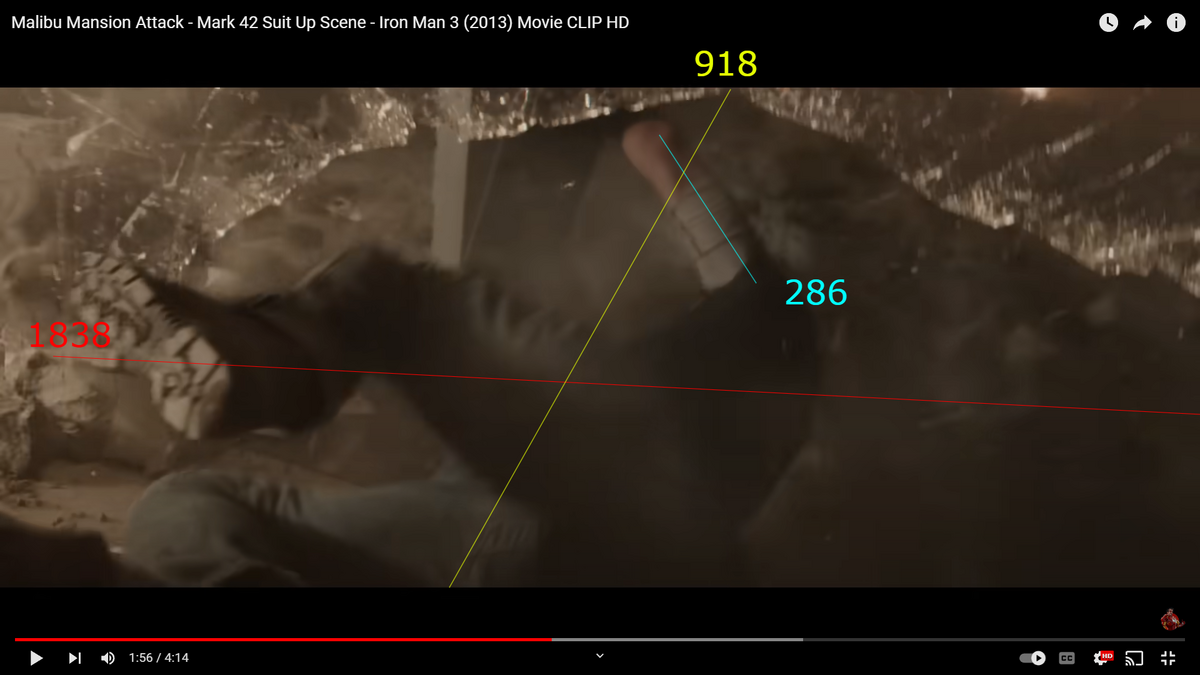
MCU Tony unarmored feats
172.72 * 800/[115 * 2 * tan(70deg/2)] = 857.98 cm | 8.57m
However, in the later scene it can be clearly seen that the actual distance is considerably greater.
Case N°6
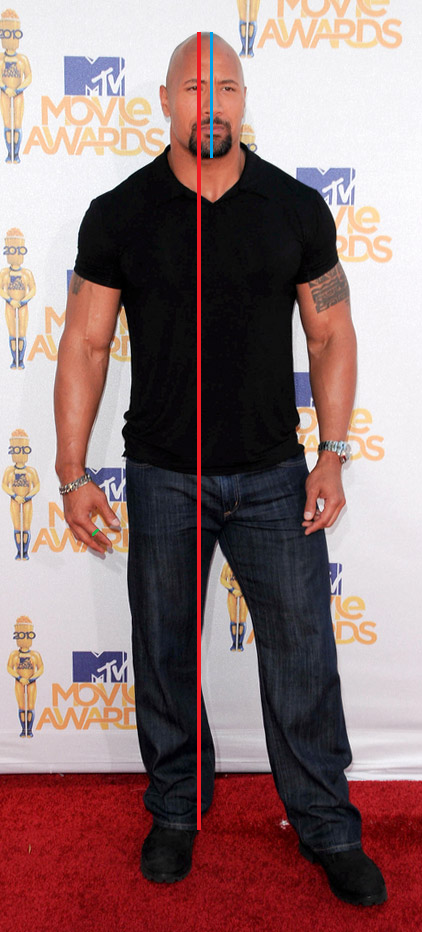
DCEU Black Adam: Black Adam catches a rocket
1.9558 * 804 /[88 * 2 * tan(70deg/2)] = 12.7m.
However, in both earlier and later scenes, it is evident that the actual distance is significantly greater, even scaling to a distance close to the rock gives me 10m and you can see that the panel is still at a much greater distance.
Case N°7
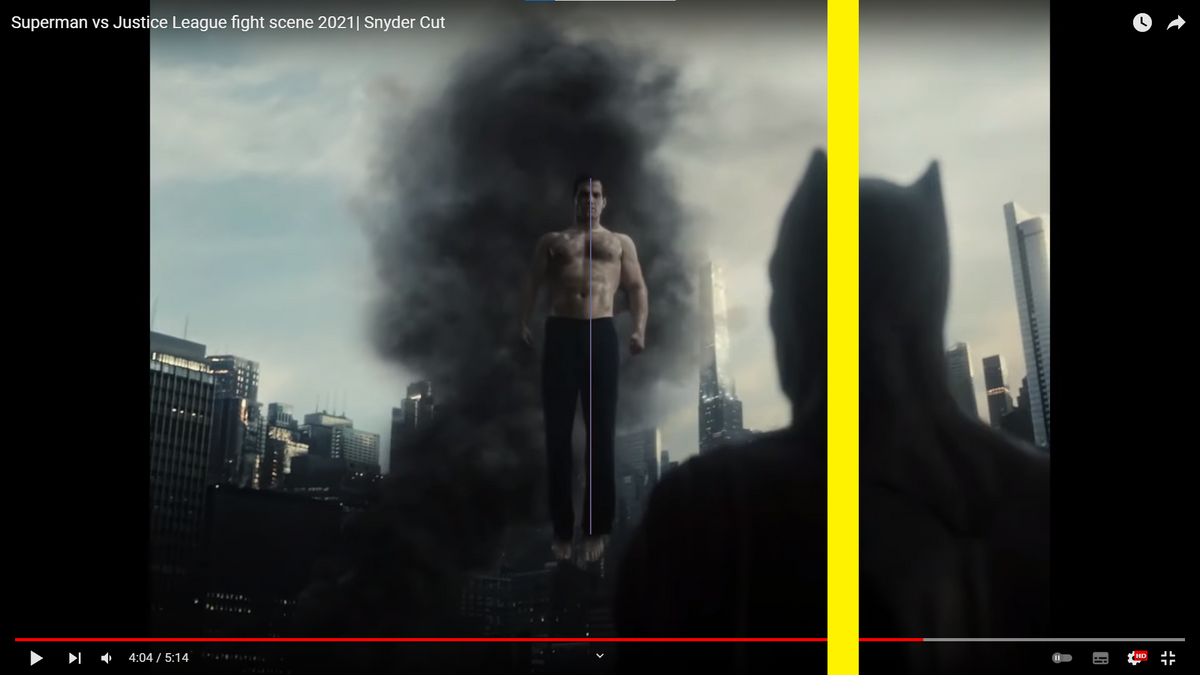
Some DCEU laser blocking
1.8415m x 1080 : (570 x 2 x tan(70deg : 2)) = 2.49m
However, the shot below demonstrates that this distance is actually greater, suggesting that the initial measurement does not accurately reflect the visual reality presented.
I can take any calculation derived from a screen capture of a movie or series using the angsizing technique to illustrate that a 70° vertical FOV is not adequate. However, I have selected specific cases that allow a clearer and more direct demonstration of this point (also because it makes me lazy to look for more cases, most of the calculations I saw are from manga feats XD).
Games
Problem with the Use of Vertical FOV
In video games, the FOV is typically horizontal and, in many cases, customizable. Many first-person and third-person games use a horizontal FOV ranging from 60° to 75°, which better fits the 16:9 aspect ratio of modern monitors and screens. Applying a vertical FOV of 70° in these games distorts the calculation of distances, resulting in an excessive horizontal FOV greater than 100°.
Examples
If a vertical FOV of 70° is used when analyzing screenshots from video games, the calculated distances between the camera and game objects would be significantly shorter than they actually are. This error can lead to misinterpretations in the analysis of feats, affecting crucial aspects like character speed or distances between key elements within the game. Consequently, applying an appropriate and representative FOV is essential for obtaining accurate results in measuring distances and actions in video games.
Proposed Solution
Use the standard horizontal FOV of 70° in video game calculations, provided the exact FOV of the game is unknown.
Investigate the exact FOV of the video game, as many games allow this value to be adjusted in settings. In cases where the game has a customized FOV, it would be advisable to use that specific value in calculations for more accurate results.
Comics and Manga
Problem with the Use of Vertical FOV
The composition of panels in comics and manga exhibits significant diversity in aspect ratios, making it inappropriate to use a vertical FOV of 70° for calculating distances. This approach can result in excessively small distances or, in the worst case, exaggeratedly wide viewing angles in panels that are particularly long horizontally. Such distortion does not reflect the reality of the illustrated images and can lead to misinterpretations regarding the scale and proximity of elements within the scene.
Comics Panels with a 16:9 Aspect Ratio
In some cases, certain panels in comics and manga have an aspect ratio resembling cinematic captures (16:9). For these panels, it is more appropriate to utilize a horizontal FOV of 70°, similar to that applied in films or series. This allows distance calculations to be more consistent and better reflects the visual experience intended.
Proposed Solution
For more traditional or vertically oriented comic and manga panels, it is advisable to use a reduced vertical field of view (FOV), such as 40°. This makes sense given the static and detailed nature of these media, where compositions tend to focus on fixed and precise elements rather than the dynamic, moving action characteristic of cinematography. In comics, attention to detail is crucial, and a narrower FOV allows these elements to be appreciated more clearly and coherently in perception.
The use of a 40° FOV in comics and manga is justified by its ability to provide a more natural and faithful representation of human perception. In photography, a 50mm lens on full-frame cameras is recognized for creating images that are perceived as balanced, without distorting or exaggerating the proportions of the scene.

(Source: “how to” by Randall Munroe))
In the context of comics, this FOV allows characters and details to be represented with greater clarity, aligning with the need to highlight key elements in a static narrative focused on details without introducing distortion.
For example, for panels such as these:

In contrast, for panels with a 16:9 aspect ratio or those similar to cinematic captures, a horizontal FOV of 70° should be applied. This ensures that distance calculations maintain consistency and that the proportions of the represented elements align with what is expected in a high-quality visual experience.
Example:

Last edited:


